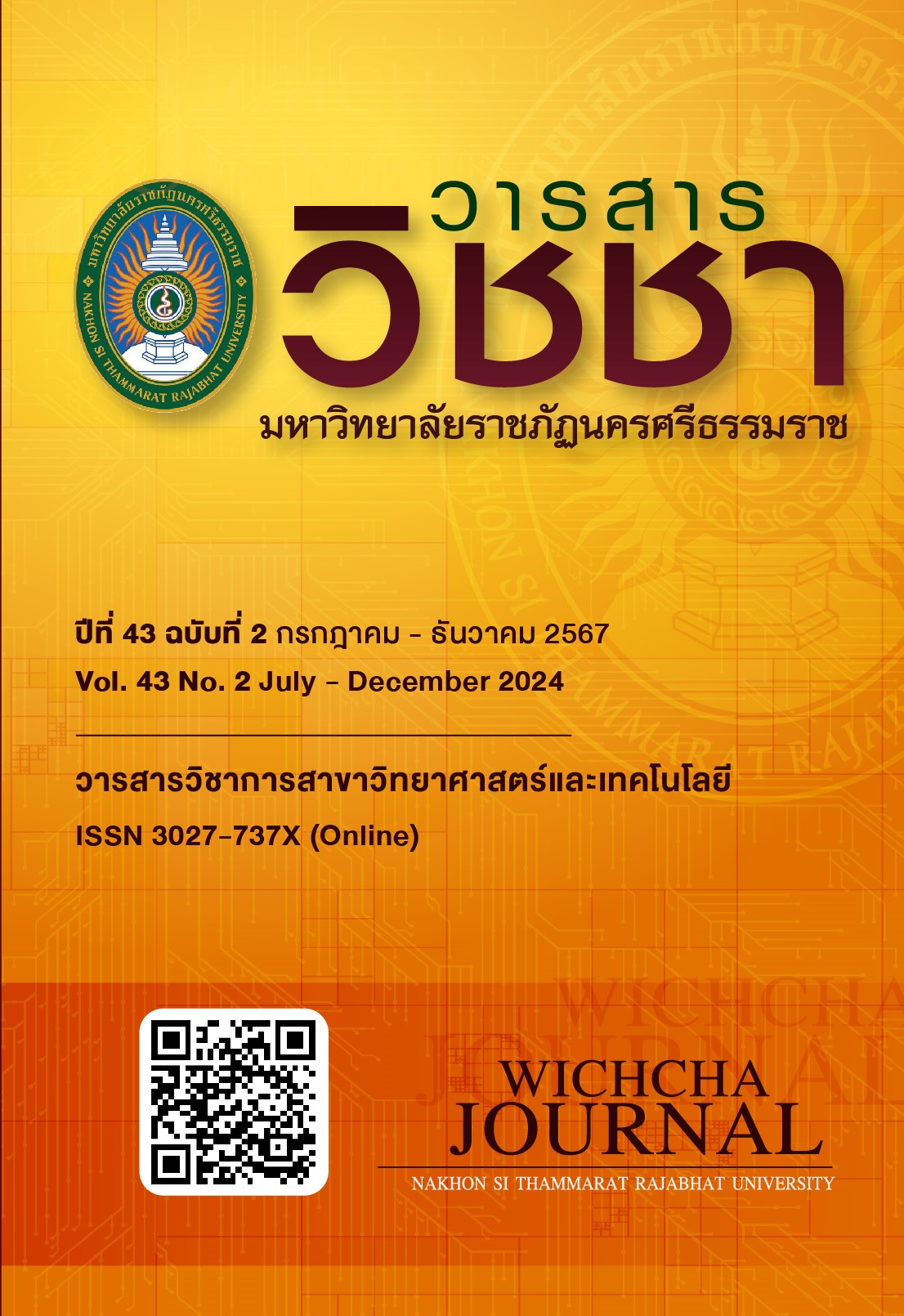ฤทธิ์ต้านอนุมูลอิสระและฤทธิ์ยับยั้งเอนไซม์ไทโรซิเนสของน้ำมันหอมระเหยจากเปลือกส้มโอ
Main Article Content
บทคัดย่อ
งานวิจัยนี้มีวัตถุประสงค์เพื่อศึกษาฤทธิ์ทางเคมีเบื้องต้น ได้แก่ ปริมาณฟีนอลิกรวม ปริมาณแทนนินรวม ปริมาณฟลาโวนอยด์รวม ฤทธิ์ต้านอนุมูลอิสระ และฤทธิ์ยับยั้งเอนไซม์ไทโรซิเนสของน้ำมันหอมระเหยจากเปลือกส้มโอจากเปลือกสีเขียวและเปลือกสีขาว โดยสกัดด้วยไอน้ำ พบว่าเปลือกส้มโอสีเขียวมีปริมาณน้ำมันหอมระเหยมากที่สุดที่เวลา 30 นาที ทำการวิเคราะห์หาปริมาณฟินอลิกรวม ปริมาณแทนนินรวม ปริมาณฟลาโวนอยด์รวม ฤทธิ์ต้านอนุมูลอิสระของน้ำมันหอมระเหยด้วยวิธี DPPH radical-scavenging assay (DPPH) และฤทธิ์ยับยั้งเอนไซม์ไทโรซิเนสด้วยวิธีโดปาโครม (Dopachrome method) จากการศึกษาพบสารพฤกษเคมีเบื้องต้นในน้ำมันหอมระเหยจากเปลือกส้มโอ ได้แก่ ฟลาโวนอยด์ (flavonoid) คูมาริน (coumarin) ซาโปนิน (saponin) แทนนิน (tannin) นอกจากนี้ในน้ำมันหอมระเหยจากเปลือกส้มโอมีโฟลบาแทนนิน (phlobatannins) และปริมาณฟีนอลิกรวม ปริมาณแทนนินรวม และปริมาณฟลาโวนอยด์ เท่ากับ 155.62±0.05 มิลลิกรัมแกลลิกต่อกรัมสารสกัด (mg GAE/g) 162.47±0.03 มิลลิกรัมแทนนินต่อกรัมสารสกัด (mg TAE/g) และ 144.82±0.05 มิลลิกรัมเคอร์ซิตินต่อกรัมสารสกัด (mg QE/g) ตามลำดับ ฤทธิ์ต้านอนุมูลอิสระด้วยวิธี DPPH พบว่ามีฤทธิ์ต้านอนุมูลอิสระดีที่สุด โดยมีค่า EC50 เท่ากับ 13.42±0.06 มิลลิกรัมต่อมิลลิลิตร และฤทธิ์ยับยั้งเอนไซม์ไทโรซิเนสด้วยวิธีโดปาโครม พบว่าสารสกัดมีฤทธิ์ยับยั้งเอนไซม์ไทโรซิเนส โดยมีค่า EC50 เท่ากับ 12.58±0.04 มิลลิกรัมต่อมิลลิลิตร โดยสามารถนำน้ำมันหอมระเหยที่ได้ไปประยุกต์ใช้ในเครื่องสำอางได้
Article Details

This work is licensed under a Creative Commons Attribution-NonCommercial-NoDerivatives 4.0 International License.
เนื้อหาและข้อมูลในบทความที่ลงตีพิมพ์ในวารสารวิชชา มหาวิทยาลัยราชภัฏนครศรีธรรมราช ถือเป็นข้อคิดเห็นและความรับผิดชอบของผู้เขียนบทความโดยตรง ซึ่งกองบรรณาธิการวารสารไม่จำเป็นต้องเห็นด้วยหรือร่วมรับผิดชอบใด ๆ
บทความ ข้อมูล เนื้อหา รูปภาพ ฯลฯ ที่ได้รับการตีพิมพ์ในวารสารวิชชา มหาวิทยาลัยราชภัฏนครศรีธรรมราช ถือเป็นลิขสิทธ์ของวารสารวิชชา มหาวิทยาลัยราชภัฏนครศรีธรรมราช หากบุคคลหรือหน่วยงานใดต้องการนำข้อมูลทั้งหมดหรือส่วนหนึ่งส่วนใดไปเผยแพร่ต่อหรือเพื่อการกระทำการใด ๆ จะต้องได้รับอนุญาตเป็นลายลักษณ์อักษรจากวารสารวิชชา มหาวิทยาลัยราชภัฏนครศรีธรรมราชก่อนเท่านั้น
The content and information in the article published in Wichcha journal Nakhon Si Thammarat Rajabhat University, It is the opinion and responsibility of the author of the article. The editorial journals do not need to agree. Or share any responsibility.
References
นภดล ลากะสงค์ ทัศนัย โสคันธิกอุบล สรวีย์ ศิริพิลา จันจิรา จรามรบูรพงศ์ สมปอง ทองงามดี อรุณรัตน์ สัณฐิติกวินสกุล และรุ่งทิวา ชิดทอง. (2565). การตรวจสอบพฤกษเคมีเบื้องต้นและปริมาณฟินอลิกรวมของใบจันทน์หอม. การประชุมวิชาการระดับชาติ ครั้งที่ 14 มหาวิทยาลัยราชภัฎนครปฐม. นครปฐม.
กิตติศักดิ์ สุขเพสน์ และรัฐพล ไกรกลาง. (2565). ปริมาณฟีนอลิกรวม ฟลาโวนอยด์รวม วิตามินซี และฤทธิ์ในการต้านสารอนุมูลอิสระของส้มโอสายพันธุ์ขาวหอม ทองดี และมณีอีสาน. วารสารวิจัยสาธารณสุขศาสตร์ มหาวิทยาลัยขอนแก่น, 15(4), 14-28.
บัณฑรวรรณ ธุระพระ จันทนา บุญยะรัตน์ เยาวเรศ ชูลิขิต และสุภาวดี ดาวดี. 2559. การวิเคราะห์ปริมาณสารสำคัญและฤทธิ์ต้านออกซิเดชันในส้มโอ. วารสารเภสัชศาสตร์อีสาน, 11(พิเศษ), 80-91.
Alam, N., Yoon, K.N., Cha, Y.J., Kim, J.H., Lee, K.R. and Lee, T.S. (2011). Appraisal of the antioxidant, phenolic compounds concentration, xanthin oxidase and tyrosinase inhibitory activities of Pleurotus salmoneostramineus. African Journal of Agricultural Research, 6(6), 1555-1563.
Ayoola, G.A., Coker, H.A., Adesegun, S.A., Adepoju-Bello, A.A., Obaweya, K., Ezennia, E.C. and Atangbayila, T.O. (2008). Phytochemical screening and antioxidant activities of some selected medicinal plants used for malaria therapy in Southwestern Nigeria. Tropical Journal of Pharmaceutical Research, 7(3), 1019-1024, doi: https://doi.org/10.4314/tjpr.v7i3.14686.
Cheong, M.W., Loke, X.Q., Liu, S.Q., Pramudya, K., Curran, P. and Yu, B. (2011). Characterization of volatile compounds and aroma profiles of Malaysian pomelo (Citrus grandis (L.) Osbeck) blossom and peel. Journal of Essential Oil Research, 23(2), 34-44, doi: https://doi.org/10.1080/10412905.2011.9700445.
Ebanks, J.P., Wickett, R.R. and Boissy, R.E. (2009). Mechanisms regulating skin pigmentation: The rise and fall of complexion coloration. International Journal of Molecular Sciences, 10(9), 4066-4087, doi: https://doi.org/10.3390/ijms10094066.
Fidrianny, I., Sari, E. and Ruslan, K. (2016). Phytochemical content and antioxidant activities in different organs of pomelo (Citrus maxima [BURM.] MERR.) using 2,2- diphenyl-1-picrylhydrazyl and phosphomolybdenum assays. Asian Journal of Pharmaceutical and Clinical Research, 9(suppl 2), 185-190, doi: https://doi.org/110.22159/ajpcr.2016.v9s2.13526.
Fisher, G.J., Varani, J. and Voorhees, J.J. (2008). Looking older: Fibroblast collapse and therapeutic implications. Archives of Dermatology, 144(5), 666-672, doi: https://doi.org/10.1001/archderm.144.5.666.
Goh, R.M.V., Lau, H., Liu, S.Q., Lassabliere, B., Guervilly, R., Sun, J., Bian, Y. and Yu, B. (2019). Comparative analysis of pomelo volatiles using headspace-solid phase micro-extraction and solvent assisted flavor evaporation. Food Science and Technology, 99, 328-345, doi: https://doi.org/10.1016/j.lwt.2018.09.073.
He, W., Li, X., Peng, Y., He, X. and Pan, S. (2019). Anti-oxidant and anti-melanogenic properties of essential oil from peel of pomelo cv. Guan Xi. Molecules, 24(2), 242-245, doi: https://doi.org/10.3390/molecules24020242.
Li, X., Guo, L., Sun, Y., Zhou, J., Gu, Y. and Li, Y. (2010). Baicalein inhibits melanogenesis through activation of the ERK signaling pathway. International Journal of Molecular Medicine, 25(6), 923-927, doi: https://doi.org/10.3892/ijmm_00000423.
Prommuak, C., De-Eknamkul, W. and Shotipruk, A. (2008). Extraction of flavonoids and carotenoids from Thai silk waste and antioxidant activity of extract. Separation and Purification Technology, 62(2), 444-448, doi: https://doi.org/10.1016/j.seppur.2008.02.020.
Tsai, C.C., Chen, H.S., Chen, S.L., Ho, Y.P., Ho, K.Y., Wu, Y.M. and Hung, C.C. (2005). Lipid peroxidation: A possible role in the induction and progression of chronic periodontitis. Journal of Periodontal Research, 40(5), 378-384, doi: https://doi.org/10.1111/j.1600-0765.2005.00818.x.
Wang, F., Lin, J., Xu, L., Peng, Q., Huang, H., Tong, L., Lu, Q., Wang, C. and Yang, L. (2019). On higher nutritional and medical properties of a carotenoid-rich mutant pomelo (Citrus maxima (L.) Osbeck). Industrial Crops and Products, 127(3), 142-147, doi: https://doi.org/10.1016/j.indcrop.2018.10.065.
Zhao, Y.L., Yang, X.W., Wu, B.F., Shang, J.H., Liu, Y.P., Dai, Z. and Luo, X.D. (2019). Anti-inflammatory effect of pomelo peel and its bioactive coumarins. Journal of Agriculture and Food Chemistry, 67, 8810-8818, doi: https://doi.org/10.1021/acs.jafc.9b02511.

